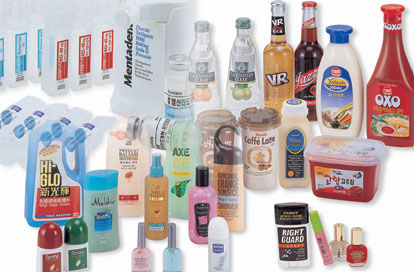The banking crisis which enveloped the world in the second half of last year struck the self-adhesive industry in the third quarter of that year. Until then producers had seen the continuing growth pattern which it had enjoyed since its large-scale expansion began in the 1970s but the sharp cutbacks in all areas produced a dramatic decline in demand, resulting in its first-ever loss of volume in 2008 compared with 2007 – albeit by only one per cent (another indication of the strength of the sector). This slowdown is expected to show a further decline of two per cent this year, followed by a static period next year and a return to modest growth from 2011. Even though annual growth rates over the next five years - forecast at 0.5 per cent to one per cent, closely following the growth in GDP – seem small, that expansion on last year’s output of 5.3 billion square metres is still a considerable amount of label materials used.

The four key areas of use are:
- variable information printing (44 per cent) for items that need individual aspects such as price and weight included;
- primary product labels identifying the brand, product, decorative effects as well as informing
customers/users of the myriad of detail that legislation now insists they contain (40 per cent);
- functional and security labels (eight per cent);
- and promotional labels which advertise price cuts, promotions – even charity fund raising stickers (eight per cent).
The greatest potential growth area is the primary product sector, which represents about 70 per cent of European demand, but this is also the area of greatest competition from alternative packaging technologies. Food products, which account for 22 per cent of all self-adhesive demand, represent the strongest of all segments and for obvious reasons will remain so.
The retail sector, which representing 16 per cent of use, has taken a knock because of the obvious reduction in consumer spending but the beverage market and health and beauty products are gaining in importance to our industry and already each account for ten per cent of use.
Futuristic labels, such as those containing micro-chips that ‘talk’ to stock control computers etc, are still the coming thing but they contain fascinating prospects for the future as the cost of their electronics come down to affordable levels.
What all this means is that there are still great opportunities for printers – and their customers – who are prepared to explore new printing techniques, effects and materials. It is a challenge for our industry – and given the large proportion of small to medium sized firms, often under family control, there is a need for FINAT to help its members capture that future.
This it is doing in the form of regular events spotlighting the coming advances and fostering a spirit of self-help between its members. Another important aspect of preparing the industry for the future is the recognition that its future leaders need to be groomed now and to this end it has just created its imaginative Young Managers’ Club to be the forum for helping these up-and-coming people develop wide-ranging skills and experiences in preparation for them to take control of their companies – and the industry as a whole – to ensure future prosperity.


